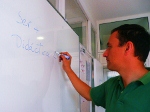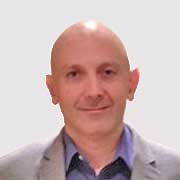My first job in Lithuania as a Spanish teacher
I arrived in Vilnius, the capital of Lithuania, a mere 20 days ago to work as as Spanish teacher at an academy. I didn’t have much experience of teaching Spanish behind me and my academic training was limited to law, which I graduated from a year ago, and Translation and Interpretation, a degree that I am about to finish. My theoretic training in Spanish teaching was done at Instituo Hemingway. That was it. I had never had to face a class of foreign students expecring to be taught Spanish. I am not going to lie, I have had doubts and moments of nervousbess, but after nearly three works in Vilna, I can honestly say that I am really glad that I had accepted this job offer, and that I would not change it for a job at a law firm in Seville, my home town.
I also have to say that my colleagues, Clara and Patricia, have helped and supported me a lot, something that has made my job at the academy much easier. I would like to thank them for their support and help.
The first class I gave consisted of six Lithuanian students of A1. And I was already met with my first problem. I didn’t actually think that I would need to use English, but given the situation (none of them could speak Spanish and I don’t speak Lithuanian – at least for now - ) I had to muster up the courage and resort to using English at times. It might not have been the most appropriate method and maybe I should have just spoken in Spanish, but in that moment, I believed that it was the best thing to do, given that I was treating them like adults, and there is a limit to how much mimicking you can do. In any case, I am trying to speak as little English as possible.
I left class quite happy and I do believe that my A1 students are making progress.
I also have groups of B1 and B2. I manage to cope really well with these groups and the classes are done entirely in Spanish. The B2 groups are, with a doubt, my favourite. They have asked that I teach them Hispanic culture and history, which are things that I am passionate about. I have managed to briefly explain, after being asked by various students, the Civil War.
As for the teaching method I use in my classes , I have to say that I try to focus on the communicative method . I try to get my students to talk a lot and I often make them do activities in pairs or groups. Naturally, I couldn’t resist showing them “the Spanish of the streets”, which you don’t usually find in textbooks.
I structure my classes in such a way that the people will enjoy them. I believe that I am generlaly successful. We also try our best to organise as many cultural activities in the academy as possible.
This here is my experiene, condensed into several lines, as a Spanish teacher in Vilna. In conclusion, I am quite happy and I believe it is a very rewarding job.



 English
English Español
Español Deutsch
Deutsch Français
Français Italiano
Italiano Ру́сский
Ру́сский 

